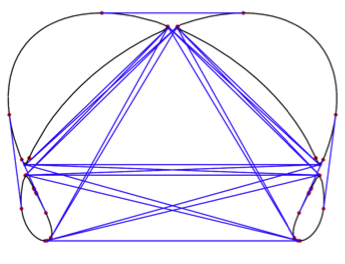The idea of this week program is to introduce the participants to algebraic geometry from two explicit angles: theta functions theory and algebraic curves. To illustrate the topics, the participants will manipulate the objects using computational software as Magma and Sage (no a priori knowledge is required on these softwares).
This short course is a prelude to the CIMPA school and it is highly recommended for the students who wish to participate. Mathematical tools that will be explained during the week have applications to coding theory, cryptography but also to algebraic statistics.
Format of the event:
There will be lectures in the morning related to various aspects of theta functions or algebraic curves. In the afternoon, we will work on specific problems with computer help.
Location:
The courses will all take place at IMBM
Tentative program of the week
|
Monday 23/08 |
Tuesday 24/08 |
Wednesday 25/08 |
Thursday 26/08 |
Friday 27/08 |
| 9-10.30 |
Ritzenthaler |
Somoza |
Ritzenthaler |
Tutorials |
Özlüm Celik |
| 10.30-11 |
Coffee break |
Coffee break |
Coffee break |
Coffee break |
Coffee break |
| 11-12.30 |
Somoza |
Ritzenthaler |
Somoza |
Tutorials |
Özlüm Celik |
| 14.30-17 |
Tutorials |
Tutorials |
Free afternoon |
Tutorials |
Tutorials |
Türkü Özlüm Celik
- (Non-hyperelliptic) curves and their period matrices.
- Multidimensional theta functions
- Reconstruction of curves from period matrices (for higher genera)
- Talk: Numerical reconstruction of curves from their Jacobians ( slides of the talk).
Abstract: We approach the Torelli problem of reconstructing a curve from its Jacobian from a computational point of view. Following the literature of algebro-geometric perspective to the Kadomtsev-Petviashvili equation, we design machinery to solve this problem effectively, which builds on methods in numerical algebraic geometry. We verify these methods via numerical experiments with curves up to genus 7. This is joint work with Daniele Agostini and Demir Eken.Talk: Reconstruction of curves from their Jacobian.
Ritzenthaler
- Talk: maximal number of rational points on (plane) curves over finite fields.
This talk will serve as introduction to the week. I will start with an overview of the topic of rational points on curves over finite fields and then restrict to the case of plane curves which will be the main focus of the first part of the course. At the end of the talk, I will explain how the analytic tools that will be deployed by the two other lecturers may be useful in the context of curves over finite fields.
- Introduction to Magma and experiments on the 1st topic ( exercise sheet).
- Challenge (computation and theoretical): maximal number of rational points on affine plane curves over finite fields.
- 2nd topic: Riemann-Roch theorem and geometry of genus 5 curves (see these notes for more details).
- Computational aspects of Riemann-Roch spaces with Magma ( solutions of all exercises).
- Challenge (computational and theoretical): trigonal genus 5 curves and genus 5 curves with non-trivial automorphism group.
Anna Somoza
- Elliptic curves over the complex numbers
- The one-dimensional theta functions.
- The Jacobian of a curve.
- Talk: The higher-dimensional theta functions, and an interesting application.
To an algebraic curve C over the complex numbers one can associate a non-negative integer g, the genus, as a measure of its complexity. One can also associate to C, via complex analysis, a g×g symmetric matrix Ω called period matrix. Because of the natural relation between C and Ω, one can obtain information about one by studying the other. Therefore, it makes sense to consider the inverse problem: Given a period matrix Ω, can we compute a model for the associated curve C? In this talk, we will introduce theta functions associated to a period matrix and see their role in answering the question above.

